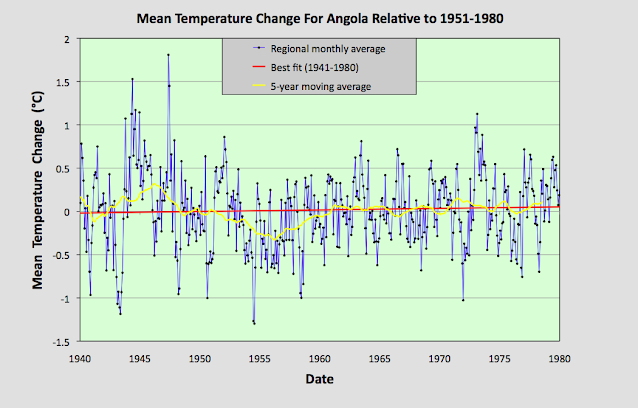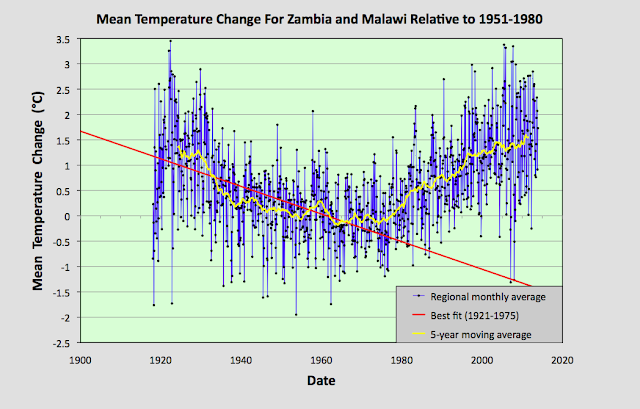The biggest problem we are confronted with when it comes to determining the extent of climate change in Angola is a lack of temperature data. There is only one long station with over 1200 months of data and another four medium stations with over 480 months of data. Only two stations have a significant quantity of data before 1939, and they are both in the capital Luanda; and none have any reliable data after 1980 due to the protracted civil war. A full list of stations for Angola can be found here.
If we include stations with over 240 months of data, then there are a total of eighteen temperature records that we can use. Their locations are indicated on the map below in Fig. 82.1. Overall they are fairly evenly distributed across the country, although the stations with the longest temperature records are generally found nearest the coast. The consequence of this deficit of data is that it is impossible to definitively determine the temperature trend for the country either before 1940, or after 1980. Between 1940 and 1980 the data suggests that no warming took place.
Fig. 82.1: The (approximate) locations of the main weather stations in Angola. Those stations with a high warming trend between 1901 and 2000 are marked in red while those with a cooling or stable trend are marked in blue.
The monthly anomalies for each station were created in the usual manner, as outlined in Post 47. First a suitable thirty year interval was chosen for calculating the monthly reference temperatures (MRTs). In this case the period 1951-1980 was chosen as that corresponded to the interval that overlapped with the maximum number of station records. The twelve MRTs for each station dataset were calculated for each of the twelve months by averaging the monthly temperatures in the reference period for that station. The MRTs were then subtracted from all the respective monthly temperature data for that station to generate the anomalies. The anomalies from all the stations were then averaged to give the mean temperature anomaly (MTA) for the region in that month. Employing a simple average of the station data rather than using Kriging, homogenization and gridding is sufficiently accurate if the stations are fair evenly distributed, which the map in Fig. 82.1 suggests to be the case. The resulting mean temperature anomaly since 1875 is shown below in Fig. 82.2.
Fig. 82.2: The mean temperature anomaly (MTA) for Angola relative to the 1951-1980 monthly averages based on an average of anomalies from stations with over 300 months of data. The best fit is applied to the monthly mean data from 1881 to 1980 and has a positive gradient of 1.39 ± 0.08 °C per century.
The MTA in Fig. 82.2 exhibits a similar warming profile to the IPCC global trends, but this is somewhat misleading. The data before 1939 is based on only two stations, and both of these are situated in the capital Luanda (Berkeley Earth ID 151475 and 2824), while the data after 1980 is highly sporadic and discontinuous for all stations with data in this period. This is illustrated in Fig. 82.3 below which shows the station frequency count in the MTA in Fig. 82.2.
Fig. 82.3: The number of station records included each month in the mean temperature anomaly (MTA) trend in Fig. 82.2.
The station with the longest data set is Luanda (Berkeley Earth ID 151475), the monthly anomalies of which are shown in Fig. 82.4 below. The second station in Luanda (Berkeley Earth ID 2824) has no data after 1973, while its data after 1951 is virtually identical to that of station 151475. Before 1951, however, the data from the two stations disagree by an average of almost 0.5°C. This hints that the two sets of station data may not be completely independent, or may be the result of combining other datasets.
Fig. 82.4: The temperature anomaly for Luanda relative to the 1951-1980 monthly averages. The best fit is applied to all the monthly mean data and has a positive gradient of 1.63 ± 0.06 °C per century.
The main conclusion to be drawn from Fig. 82.3 is that both the data before 1939 and the data after 1980 are unreliable. The data after 1980 is unreliable because there is so little of it, and it is highly fragmented. The data before 1939 is unreliable because it is based on just two stations that are located in the most highly populated region of the country. While these two stations do corroborate each other, particularly after 1951, they are still unlikely to be representative of the climate of the country as a whole. We know this because we see it in many countries and regions: strong warming in the major cities like Jakarta (see Post 31), Sydney (BE-151986) in NSW (Post 18) and Melbourne (BE-151813) in Victoria (Post 19), but a totally different temperature trend in the surrounding region.
Fig. 82.5: The mean temperature anomaly (MTA) for Angola relative to the 1951-1980 monthly averages based on an average of anomalies from stations with over 300 months of data. The best fit is applied to the monthly mean data from 1941 to 1980 and has a positive gradient of 0.18 ± 0.17 °C per century.
If we therefore just look at the data from 1940 to 1980 we see that there is no significant warming (see Fig. 82.5 above). The slight rise in the best fit line is at least five times less than the standard deviation of the MTA, and is almost the same as the uncertainty in the best fit. And this is also similar to the extent of the warming claimed by Berkeley Earth for this period (see Fig. 82.6 below).
Fig. 82.6: The temperature trend for Angola since 1840 according to Berkeley Earth.
However, the temperature trend for Angola according to Berkeley Earth (BE) does exhibit strong warming both before 1939 and after 1980. While the latter is certainly a reasonable assumption based on trends elsewhere in the region, it is not a conclusion that can be confidently presented based on the available data. As for the data in Fig. 82.6 before 1939, this may be supported by the station data from Luanda, but it differs significantly from the trends I have determined for neighbouring countries such as Namibia (Post 39), Botswana (Post 38), Zambia (Post 81) and Zimbabwe (Post 79).
Summary
Temperatures in Angola between 1939 and 1980 appear to be stable.
There is insufficient data to determine the extent of climate change in Angola either before 1939, or after 1980.
Acronyms
BE = Berkeley Earth.
MRT = monthly reference temperature (see Post 47).
MTA = mean temperature anomaly.












